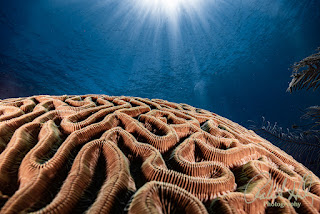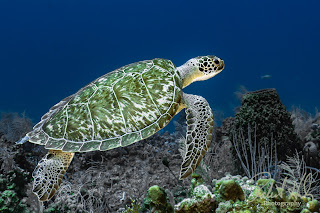Mastering Split-Toning for Unique Underwater Color Effects
Split-toning is often regarded as one of Lightroom's hidden gems. It provides excellent opportunities for creativity, especially for underwater photographers eager to enhance their images with a touch of artistic flair. This advanced technique enables photographers to selectively apply various hues to the highlights and shadows of their images, resulting in vibrant color gradients. These gradients not only elevate the overall mood of the photograph but also skillfully guide the viewer’s eye toward particular areas of interest in the composition.
As we delve into the world of split-toning, I will take you through the essential steps to master this technique in Lightroom. We will explore leveraging the latest AI tools and incorporating efficient keyboard shortcuts to streamline your editing workflow and maximize creativity.
I will also present five examples explicitly tailored for underwater photography to deepen your understanding of split-toning. Each example will be accompanied by expanded insights, tips, and techniques that can be applied to your work, ensuring you can make the most of this powerful editing tool. So, let’s dive into this enriching journey of color and creativity!
What is Split-Toning?
Split-toning enables you to independently add hues to an image's highlights and shadows, creating a subtle or dramatic color contrast. This technique is ideal for underwater photography, where different lighting conditions and watercolors can sometimes flatten shots.
Getting Started with Split-Toning in Lightroom
- Open
your photo in Lightroom’s Develop module (D).
- Navigate
to the Color Grading panel on the right sidebar.
- Adjust
the hue, saturation, and luminance for shadows, midtones, and highlights
using the color wheels or sliders.
- Use
the Balance slider to control the blending between shadows and
highlights.
- Apply
AI tools such as Masking for targeted edits before split-toning.
Don’t hesitate to experiment with the Global color
wheel to introduce overarching tonal adjustments that complement your
split-toning. Lightroom’s AI can also suggest areas for improvement with the Enhance
AI feature, which is accessible from the masking tools.
Now, let’s explore five examples of split-toning for underwater photography, with step-by-step instructions and expanded techniques for each effect.
Five Creative Examples of Split-Toning for Underwater
Images
1. Classic Teal and Orange Contrast
This timeless combination brings out the blues of the water
and warms up your subject—perfect for divers or marine life.
Steps:
- Open
your photo in the Develop Module (D).
- Go to
the Color Grading panel (formerly Split-Toning).
- Adjust
the Highlights Hue slider to a warm orange (30–50) and set the Saturation
to around 20.
- For Shadows,
move the slider to teal (180–200) with a saturation of 25–30.
- Use
the Balance slider to fine-tune the interplay between teal and
orange.
- Keyboard
Shortcut: Use Shift + T to quickly access the Color Grading
panel.
- Use
Lightroom’s AI tools, such as Masking, to isolate your subject and
refine color contrast for extra impact.
2. Deep Ocean Mystery
For a dramatic, moody feel, enhance the shadows with dark
blues and add subtle greens to the highlights.
Steps:
- Navigate
to the Develop Module and open the Color Grading panel.
- Set
the Highlights Hue to green (120–135) with a saturation of 15.
- Adjust
the Shadows Hue to navy blue (220–240) and push saturation to 30.
- Set
the Midtones Hue to cyan for a smooth transition.
- Fine-tune
the Balance to favor shadows.
- Enable
AI-Powered Select Subject Mask to isolate your diver or marine life
and adjust its exposure for emphasis.
- Keyboard
Shortcut: Use O to toggle the overlay on your mask.
3. Sunlit Coral Reef Glow
This style mimics the warm, golden light you see during
shallow dives over coral reefs.
Steps:
- Open
the photo in the Develop Module and access the Color Grading
panel.
- Adjust
the Highlights Hue to yellow (50–70) and set saturation to 40.
- Shift
the Shadows Hue to purple (280–300) with a saturation of 20.
- Add a
slight magenta hue to the Midtones for a dreamy feel.
- Apply
a Linear Gradient Mask (M) to warm up the foreground where
the coral reef is located.
- AI
Shortcut: Use the Depth Mask to isolate deeper water layers
for natural blending.
4. Vibrant Reef Pop
Objective: Make colorful reefs and marine life pop
with complementary tones.
Steps:
- Select
a magenta hue (330°) for highlights and increase saturation to 50.
- For
shadows, choose a cyan hue (180°) with a saturation of 40.
- Move
the Balance slider toward +30 to prioritize magenta highlights.
- Use
the Brush Mask Tool (K) to paint over specific reef areas and apply
split-toning only where needed.
- Leverage
AI Enhance Details to sharpen textures after split-toning.
- Add
vibrance (Shift+Alt+V) to increase the saturation of less dominant colors
without oversaturating already vivid areas.
Shortcut Highlight: Press K to toggle the
Brush Mask Tool on/off during adjustments. This approach enhances tropical lagoon shots, balancing
turquoise water with bright, vibrant accents.
Steps:
- Open
the image in the Develop Module.
- In the
Color Grading panel, set the Highlights Hue to turquoise
(170–190) with a saturation of 50.
- Adjust the Shadows Hue to magenta (290–310) with a saturation of 35.
- Push
the Midtones toward the green to emphasize lush surroundings.
- Use AI
to select the sky and water separately, adding texture or clarity for
realism.
- Keyboard
Shortcut: Use K for the Brush Tool to fine-tune masked areas.
5. Ethereal Twilight Underwater Scene
This effect is perfect for evening dives or shots with low
ambient light, creating a soft, mystical atmosphere.
Steps:
- Navigate
to the Develop Module and the Color Grading panel.
- Set
the Highlights Hue to pale pink (320–330) and saturation to 20.
- Adjust
the Shadows Hue to deep blue (210–230) with a saturation of 40.
- Balance
the two hues for a smooth, ethereal gradient.
- Apply a Radial
Gradient Mask (Shift + M) around your main subject to emphasize the color effects softly.
- Use
the AI-Powered Noise Reduction tool to clean up low-light
artifacts.
Pro Tips for Split-Toning Success
- Start
Subtly: It’s easy to overdo split-toning. Begin with low saturation
values and build up gradually.
- Experiment
with Balance: The Balance slider is your best friend for refining the
interaction between highlights and shadows.
- Leverage
AI Masks: Lightroom’s AI capabilities can isolate elements like
subjects, water, or coral for precise adjustments.
- Save
as a Preset: Once you create a look you love, save it as a preset for
future use.
- Keyboard
Shortcut: Use Ctrl + Shift + N (Windows) or Cmd + Shift + N
(Mac) to create a new preset.
- Use
Before & After View: Toggle the *|* key to compare edits
with the original image.
Final Thoughts
Split-toning is a fantastic way to push your creativity and
add a unique touch to your underwater photography. By experimenting with these
examples, you’ll discover endless possibilities to elevate your images. Have
fun exploring the depths of Lightroom’s capabilities, and don’t forget to share
your masterpieces with our Oceanic Explorer community!
Ready to dive into more editing tips? Check out my other
Lightroom guides at RobertHerb.blogspot.com.
Written by Robert Herb – empowering underwater photographers to capture and enhance the beauty of our oceans.
Stay Connected
Follow my blog for more tips and tutorials on underwater photography. Let's dive deeper into the art and craft of capturing the marine world!
Subscribe to my blog for more tips and tutorials on underwater photography. Remember to share your processed photos on social media using the hashtag #RobertHerbPhotography. I look forward to reviewing your results.
New Online Training Program
I am excited to announce that I am creating an online training program to teach underwater hobbyists and enthusiasts how to enhance their photos using Adobe Lightroom. If you are interested in this training or need more information, please go to (Underwater Photo Training) or contact me at bob@robertherb.com to express your interest and to be notified about the details and start date of the classes.
Stay tuned and "Follow" for upcoming blogs on underwater photography tips and tricks for more in-depth insights. Please leave your comments and suggestions. Enjoy your diving and shooting experience!
I am eagerly anticipating your valuable feedback and suggestions.
Sincerely,
Bob Herb
|
|





Comments
Post a Comment
Please let me know your comments.